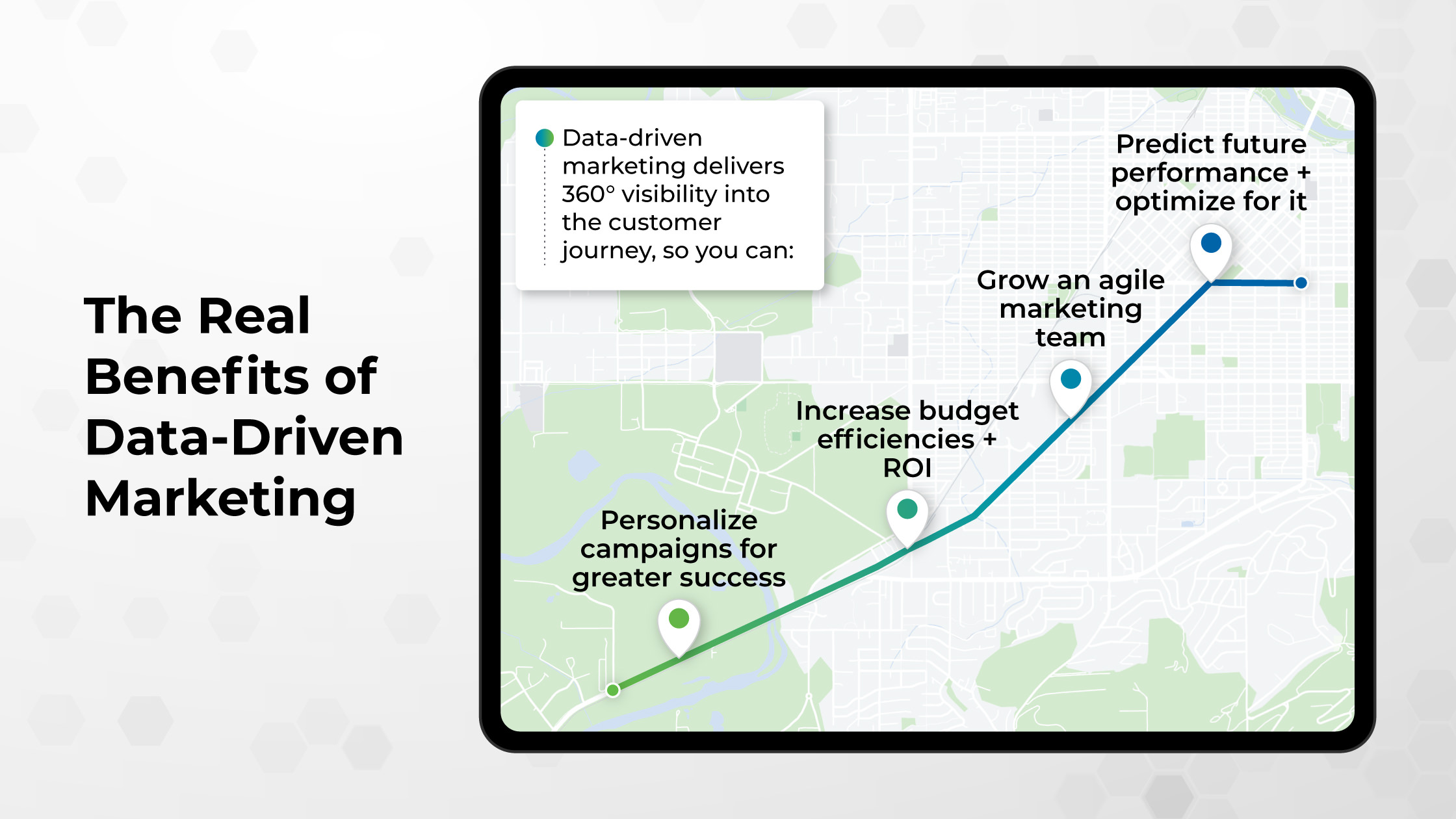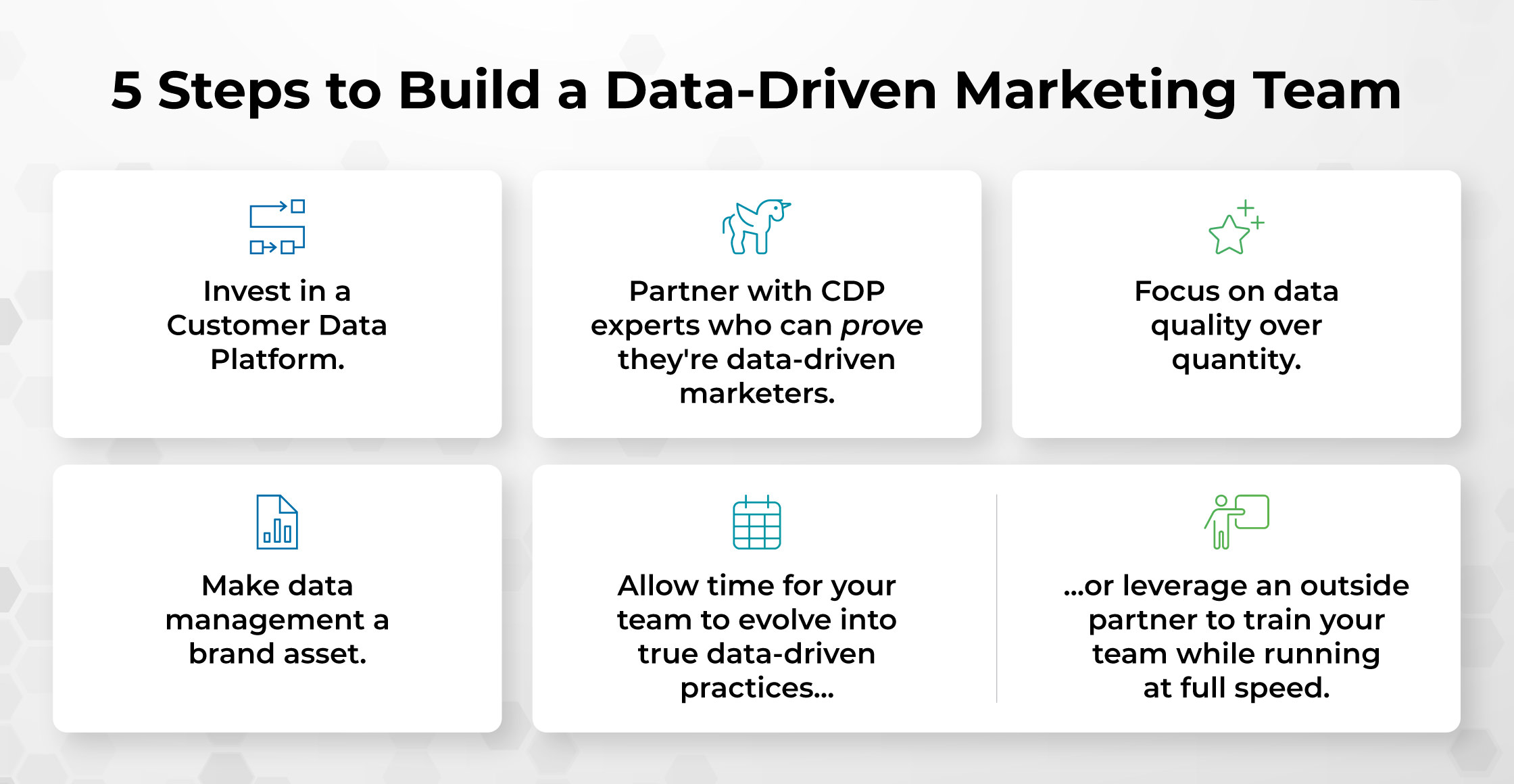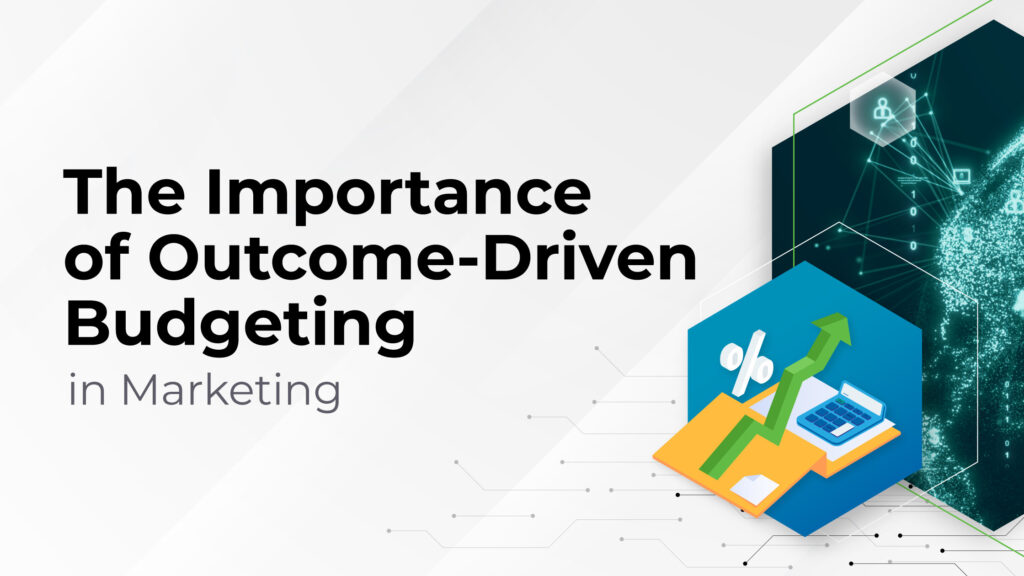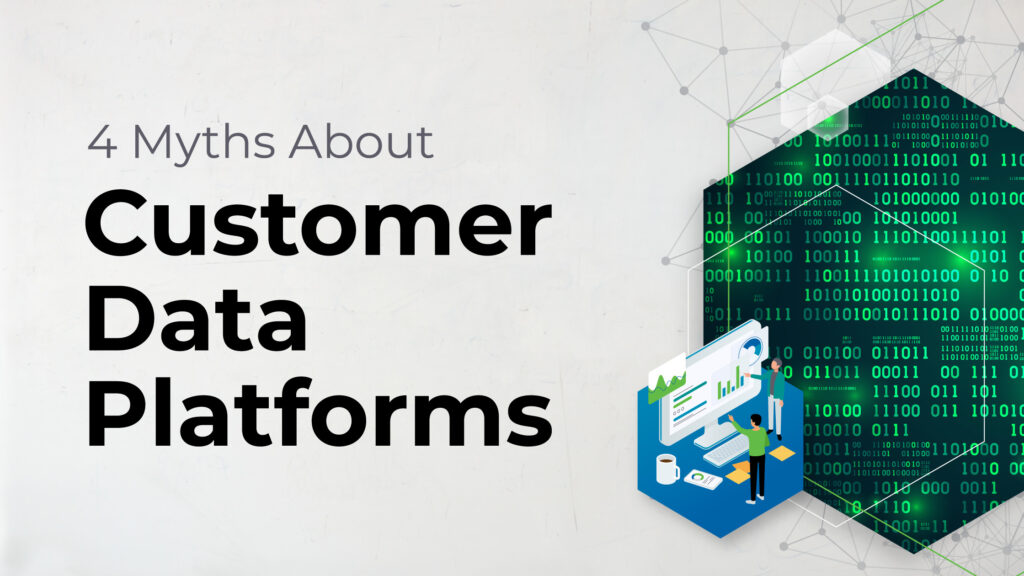
More than ever, “data-driven marketing” has been on the lips of marketers and brand leaders everywhere.
However.
The vast majority of those marketers and brand leaders are talking the talk of data-driven strategies, but not walking the walk.
Some of these folks are fully aware they’re blowing smoke, but in our opinion, most have no idea that their day-to-day marketing operations and big picture business decisions are miles away from being truly data driven.
So what is data-driven marketing, in its purest form?
And how can you know if you’re inadvertently operating under the illusion of it, instead of the real deal? We’re about to help you answer those questions.
- 6 reasons why most marketers THINK they’re data-driven, when they’re not
- The game-changing benefits of data-driven marketing strategies
- How to overcome the hurdles of managing all that data
- Real examples that bring data-driven marketing to life
6 reasons why most marketers THINK they’re data-driven, when they’re really not.
Disclaimer: If you see yourself or your team in the descriptions below, please know that we’re not trying to blame and shame anyone. We believe in telling the truth, even when it’s hard.
Our goal is to open a dialogue about the state of modern marketing, and to support the evolution of the brands we partner with – today and tomorrow.
1. Daily analytics checks are creating a false sense of accomplishment.
Just because you or someone on your team reviews the analytics for various channels every day, that doesn’t automatically admit you to the data-driven marketing club.
Individual channel analysis is NOT data-driven marketing. Isolated data checks are always a red flag.
Real data-driven marketing requires connecting dots across platforms to form a cohesive picture of the customer journey and where it is currently ebbing and flowing, in order to make strategic and calculated movements against that data. But all that is impossible when data is compartmentalized in various silos.
How To Map Your Customer’s Journey
Explore our comprehensive guide on creating customer journey maps. Learn practical steps to understand and enhance your customer’s path today.
2. The quantity of data you’ve already gathered is not as impressive as you think.
When we first meet brands, someone on their team invariably says, “We’ve got soooo much data! Yay us!” but marketers have to resist equating data quantity with quality.
Having a mountain of data does not translate into data-driven marketing if:
- There are data gaps in important martech systems.
- Data analysis is inconsistent, or zeroes in on the same 2-3 metrics every time.
- Data is not unified. (This is the big mama.)
- Data is not relevant to the brand’s current product suite and/or market positioning.
- Data is not compliant with CCPA, GDPR, and other data privacy and security regulations.
3. Sophisticated visuals are mistaken for actionable insights.
We have huge respect for the value of effectively visualizing information (Seriously, did you see what we did for Data Security + Privacy Best Practices?) – both for the end user, and for the growth analysts building the data-driven marketing strategy to convert and retain that end user.
However, on numerous occasions, we’ve seen the sleek visuals and pretty aesthetics of well-designed spreadsheets and graphs get mistaken for genuine insights.
- Do these beautiful visuals reliably project future customer behavior that your team can optimize for now?
- Is that hefty spreadsheet looking at individual metrics or the relationship between sets of metrics?
- Has all this data been fully unified using a Customer Data Platform?
Sure, those pie charts might look impressive in a presentation, and they might even provide a comforting sense of control, but leaders must bring a healthy dose of critical analysis to all the color-coordinated loveliness.
CDP vs CRM vs DMP: Which One Do You Need?
When it comes to customer data platforms, do you need a CDP vs CRM vs DMP? Come learn the differences between them, and which one drives performance the most.
4. Someone said that certain customer data signals are out of reach and you believed them. (They were wrong.)
One of the most pervasive myths in the marketing world is the belief that certain customer data signals are inherently inaccessible. This kind of shrug-and-carry-on thinking needs to go.
Thanks to substantial advances in data aggregation and analytics technologies, brands now have access to an unprecedented wealth of customer information.
Yes, even in light of the iOS privacy changes, new email performance standards, data privacy regulations, and death of third-party cookies.
All relevant customer data can be tracked and measured. ALL OF IT.

Got a customer data signal that can’t be tracked?
5. Teams lack a deep understanding of leading and lagging indicators.
A true data-driven marketing strategy looks at EVERYTHING and lets the data inform the appropriate response. This means digging into both leading and lagging indicators.
- Leading indicators are predictive. They signal future events.
- Lagging indicators are retrospective. They provide insights into the historical performance of marketing campaigns.
For instance, a dip in organic search traffic can be a leading indicator for fewer conversions down the line. On the other hand, let’s say you see a dip in revenue (a lagging indicator) signaling that something is amiss at an earlier stage of the funnel.
If your team had noticed that dip in organic search and addressed it swiftly (because they accurately interpreted it as a precursor for fewer sales) you could’ve nipped it in the bud instead of waiting until the end of the month or quarter to start looking for a remedy.
Close monitoring of leading and lagging indicators is an essential component of practicing data-driven marketing.
6. And then there’s the humility check…
Many brand leaders resist the suggestion that their marketing is not as data-driven as they thought, because their own personal set of data points contradicts the assertion.
- You have many years of experience.
- You have an undeniable track record of success.
- Your peers and team complement you for being a pragmatist, logical, and highly intelligent.
So if all that is true, and you believe your marketing strategy is driven by data, you must be right. Right?
Leaders who are willing to rethink “how we’ve always done it” and consider that there might be a new and improved way, are the leaders whose tenure will remain unshakeable.
The real benefits of data-driven marketing
Imagine steering a ship in the dark with nothing but the stars to guide you – that’s what old-school marketing is like.
Data-driven marketing, on the other hand, is like navigating with a state-of-the-art GPS that:
- Leverages deeper layers of customer data to understand and personalize their journey
- Analyzes market trends and intent signals to predict and optimize for future activity
- Uses website analytics to tailor marketing campaigns for higher success rates.

Benefit #1: The greater the personalization, the greater the performance.
Imagine a customer journey characterized by marketing messages so relevant they feel 100% tailor-made for each recipient – that’s the power of data-driven personalization.
But personalization is so much more than just “Dear [First Name]” emails.
This is about creating a customer journey so unique that each touchpoint feels like it was designed just for them – because it was. Data can reveal invaluable insights into things like:
- Lifecycle stage
- Purchase history
- Geolocation
- Device and channel preferences
- Engagement metrics
- Stakeholder dynamics
This contextual data transforms personalization from a mere marketing tactic into a profoundly relevant and irresistible customer experience. And with that level of specificity serving up exactly what each customer segment wants, the performance gains come rolling in.
Benefit #2: Higher ROIs
Data-driven insights allow you to focus on strategies that work, while trimming away those that don’t. It’s like having a dedicated financial advisor looking over your marketing budget, guiding you to only invest in campaigns that offer the best returns.
And who wouldn’t want their marketing budget to work harder than an overly caffeinated accountant during tax season?
Data-driven marketing strategies are the only way to be sure that every dollar spent is a dollar spent wisely.
The Importance of Outcome-Driven Budgeting in Marketing
Learn how outcome-driven budgeting can revolutionize your marketing strategy, ensuring every dollar spent directly aligns with desired results.
Benefit #3: Improved agility
In today’s fast-paced market, agile marketing isn’t just an option to consider – it’s a necessity.
Market trends and customer behaviors change in the blink of an eye, which is why teams must be structured to respond swiftly and smartly.
Data-driven marketing is inherently agile because it taps ALL available customer data, including the competitive landscape and broader market context, and nimbly pivots as needed – not based on a whim, based on the numbers.
Is Agile Marketing The Future in a Post-Linear World?
Learn the importance of agile digital marketing in a performance marketing environment that demands quick, adaptive marketing teams.
Benefit #4: Shorter sales cycle
At its core, data-driven marketing is about executing a marketing strategy that’s:
- Measurable
- Predictable
- Repeatable.
By mapping out all data points and understanding their implications, data-driven marketing strategies can be refined and repeated with confidence, leading to consistent success and shorter conversion cycles.
Common challenges of data-driven marketing
While “Go data or go home” is our unabashed motto forever, we certainly don’t mean to imply that implementing data-driven marketing is an easy endeavor – its difficulties are part of why so many brands don’t operate within a truly data-driven paradigm.
Data-driven marketing delivers immense rewards yet presents formidable challenges that can trip up even the most seasoned marketers. Let’s dive into some of the core issues and their solutions.
Challenge #1: REAL data-driven marketing expertise is highly nuanced (aka: rare).
Most marketers rely on a myopic focus on single KPIs like sales or conversions, which tends to obscure the health of the overall customer journey.

Data-driven growth marketing requires a holistic view of all customer interactions (from initial awareness to purchase), along with the experience and tools to interpret the most salient performance insights within that data and take action accordingly.
Marketers must thoroughly analyze the leading and lagging indicators that connect the dots across the entire customer journey. Otherwise, brands risk missing the nuances of early engagement or post-purchase feedback, which then cascades into missing opportunities to optimize the entire funnel.
Does all this sound complex? That’s because it is, which is why the average marketer isn’t doing it. REAL data-driven marketing expertise is far less common than all those LinkedIn bios want you to believe.
Instead of narrowing in on the obvious primary KPIs, data-driven experts crawl into the weeds of secondary and tertiary data sources like:
- Organic traffic
- Bounce rate
- Pages per visit
- Email open + click-through rates
- Social media mentions
Analyzing all these things in context helps marketers understand the up/down side of existing marketing efforts, and determine how best to optimize the funnel.
Challenge #2. Stockpiling data creates a false sense of accomplishment.
As we mentioned above, beware the Paradox Of Plenty.
Many brands quickly amass vast stores of data and conclude that surely, this must mean they’re data-driven marketers. (It doesn’t.)
The first challenge lies in discerning what portions of that data actually matter. Data-driven marketers constantly seek greater and greater efficiencies, which is why they prioritize data that offers genuine insights into customer behavior and marketing performance, instead of getting lost in a sea of numbers that contribute little to strategic decisions.
The second challenge is in storing and handling that data in a way that doesn’t expose the brand to legal and PR nightmares. This is a hefty topic we explored more fully here:
Data Privacy vs Data Security: A Guide for Business Leaders
Unlock the secrets of data privacy and security. Learn the differences, legal requirements, and best practices for all business leaders in protecting user data.
Challenge #3: Data-driven marketing and data silos cannot coexist, but most brands are operating with highly siloed data.
Data that is compartmentalized across different departments or platforms will severely hamper any growth goal. (Right now. It’s actively restricting your growth. Right this minute.)
The key to overcoming this challenge is to implement a customer data platform (CDP) that allows for a cohesive analysis across all customer touchpoints and is accessible to every senior leader in every department.
Without a CDP, achieving a unified marketing approach will remain a distant dream.
4 Myths About Customer Data Platforms (CDPs)
Data-driven marketing without a Customer Data Platform (CDP) is impossible. Come learn what a CDP is, and why it’s essential for optimizing performance.
Challenge #4: Data-driven marketing is more than an ideology – it’s a set of skills that takes time to sharpen.
The best tools in the world are useless if your team doesn’t know how to extract their full value.
And to extract that value requires a mix of sophisticated strategic thinking and technical expertise that doesn’t just appear after attending a few weekend webinars.
Brands must exercise patience as their internal teams realign around a truly data-driven worldview, and develop the skill set needed.
Brands who are unwilling to wait for that process to unfold naturally need to partner with that expertise so they can keep running while training up internal resources.
If we were to strip away all the complexity, it really comes down to these three things:
- Invest in a high-quality CDP.
- Onboard or partner with data-driven experts who can utilize that CDP effectively.
- Train your team to properly read and analyze primary, secondary, and tertiary data markers.
Having the right tools is one thing; knowing how to use them well is something else entirely.

Examples of data-driven marketing strategies
While some marketers believe hoarding data is the whole ballgame, category leaders are more focused on cracking open the right data to unleash actionable insights. Here are some examples of what this looks like in practice:
Customer journey mapping
Customer journey mapping is not an idealistic exercise in hopes and wishes. This comprehensive, data-driven analysis of the user journey tells marketers exactly where and how to streamline the conversion process by identifying:
- Patterns
- Bottlenecks
- Pathways
- Opportunities.
For example, let’s say an eCommerce brand notices that a significant number of potential customers drop off at a specific point during the checkout process. Deeper analysis provides insights into why this specific location is the cause of the interruption to the sales cycle.
Armed with this insight, optimization steps might include:
- Streamlining website navigation
- Offering more (or better quality) education at crucial decision-making stages
- Refining the checkout page.
Effective customer journey mapping allows you to choreograph every step of the customer experience with precision, turning casual browsers into loyal fans by anticipating and meeting their needs at every turn.
Segmentation and targeting
Many brands are still certain that the “one-size-fits-all” approach to marketing is the gold standard. It’s not – not even close.
Each brand’s marketing solution is (should be) distinct, which is why segmentation and targeting are non-negotiables. The typical segmentation factors most marketers are familiar with include:
- Demographics
- Brand engagement
- Channel preferences
- Lifestyle
- Past purchases.
Less commonly used (and highly effective) segmentation considerations that we strongly recommend considering are:
- Psychographics
- Geodemographics
- Technographics
- Purchase intent
- Value segmentation

Overly simplistic segmentation is still the standard inside most marketing programs, which is why many brand leaders don’t have the ENORMOUS respect they should have for segmentation – because they’ve only applied it in fairly generic ways, which hasn’t netted them impressive results.
Whatever your segmentation efforts have been to date, go deeper.
Data-driven marketing reveals who your customers are at the most granular level, which supports tailoring every single content marketing touchpoint to resonate and activate each segment more quickly and repeatedly.
Data-driven micro targeting is essential for the most sustainable performance gains.
For example, let’s say that after unifying all their data streams, a health & wellness brand’s marketing analytics dashboard reveals that a sizable segment of their audience prefers eco-friendly products, but sustainability has not been emphasized in their funnel content to date.
Targeted campaigns highlighting the brand’s sustainability efforts would support increased engagement and conversions within that group.
By harnessing the power of segmentation and targeting, you transform a sea of data into a map, guiding your messaging to land with pinpoint accuracy on the audiences most primed for engagement and conversion.
A/B testing
A/B testing pits two versions of your marketing assets against each other to see which one performs better.
Seems practical, right? Unfortunately, many marketers are very impractical about how they select what should be tested.
The time and budget required to conduct any test should be applied with great discernment, which is why A/B testing based on gut feelings instead of pulling straight from the data is… Just don’t do it.
For example, a B2B tech brand might learn that over 50% of the young Millennial segment of their audience who land on their most high-converting landing page exits before viewing the full page.
Based on a hypothesis that this audience is indicating a preference for more concise content, the team can A/B test the original page against a shorter version of the landing page and specifically target its younger audience to glean insights.
Growth marketing is constant testing – but not casual or impulsive testing. Strategic. Methodical. Data-driven tests.
TL;DR on Data-Driven Marketing
- Most marketers think they’re data-driven, but they’re usually:
- Not accessing all available data
- Drawing flawed conclusions based on data silos
- Focusing on a short list of KPIs and ignoring the profound relevance of analyzing leading and lagging indicators.
- Data-driven marketing uses customer data, market trends, and website analytics to predict and shape future marketing strategies, moving beyond basic metrics toward a holistic view of the complete customer journey.
- A true data-driven approach brings numerous benefits including hyper-personalization of marketing messages, increased ROI through targeted campaigns, enhanced agility to adapt to market changes, and improved performance that leads to shorter sales cycles.
- Common challenges of data-driven marketing include navigating the overwhelming amount of data to find actionable insights, breaking down data silos for a unified strategy, and addressing skill gaps to effectively leverage data analytics.
- Real-world strategies like customer journey mapping, segmentation and targeting, and A/B testing showcase how data-driven insights can be applied to create more efficient, personalized, and successful marketing campaigns.










